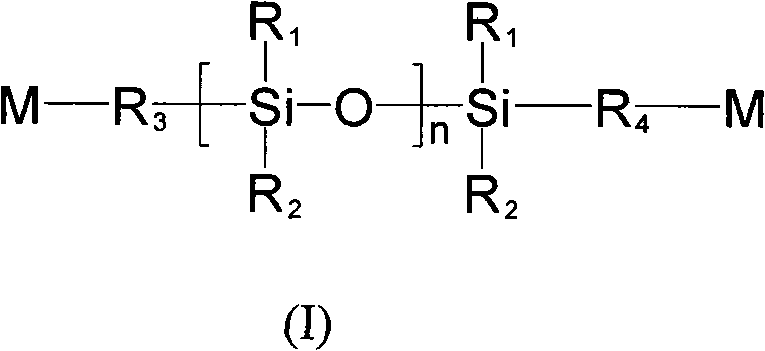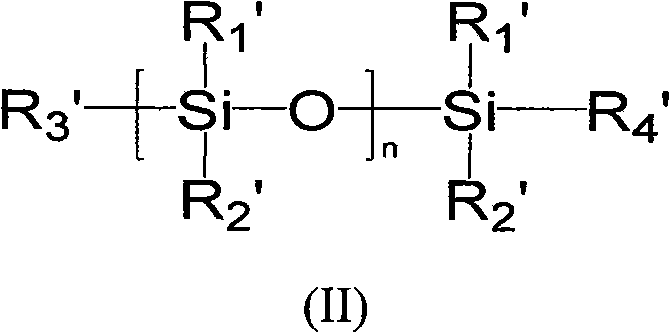Macromolecule photoinitiator for gradient polymerization as well as synthesis method and application thereof
A technology of photoinitiators and macromolecules, applied in the field of macromolecular photoinitiators for gradient polymerization and its preparation, can solve the problems of photocuring surface oxygen inhibition and other problems
- Summary
- Abstract
- Description
- Claims
- Application Information
AI Technical Summary
Problems solved by technology
Method used
Image
Examples
Embodiment 1
[0055] Synthesis of 184-Tego2342 Silicone Macromolecular Photoinitiator
[0056] 7g (2.5mmol) of Tegomer 2342 (DEGUSSA company) whose molecular formula is Formula 1 and 1.133g (5.5mmol) of DCC (dicyclohexylcarbodiimide) were dissolved in 150mL of ethyl acetate, and stirred at room temperature for 30 Minutes, 1.02 g (5 mmol) Irgacure 184 (1-hydroxycyclohexyl phenyl ketone) was added dropwise, and the reaction was carried out at room temperature for 24 hours after the addition. After filtering, the filtrate was washed three times with 5% NaOH solution and deionized water, and finally the solvent was distilled under vacuum to obtain a liquid product with a molecular formula of Formula 2. The number-average molecular mass was determined to be 3001 by gel chromatography (GPC). In the infrared spectrum, 3300cm -1 The nearby hydroxyl absorption peak disappears at 1752cm -1 The characteristic absorption peak of ester group appeared.
[0057]
[0058] Formula 1
[0059] From th...
Embodiment 2
[0063] Synthesis of HBP-Tego2342 Silicone Macromolecular Photoinitiator
[0064] 7g (2.5mmol) of Tegomer 2342 (DEGUSSA company) whose molecular formula is Formula 1 and 1.133g (5.5mmol) of DCC (dicyclohexylcarbodiimide) were dissolved in 150mL of ethyl acetate, and stirred at room temperature for 30 Minutes, 0.99g (5mmol) of HBP (4-hydroxybenzophenone) was added dropwise, and the reaction was completed at room temperature for 24 hours. After filtering, the filtrate was washed three times with 5% NaOH solution and deionized water, and finally the solvent was distilled under vacuum to obtain a liquid product with a molecular formula of Formula 3. The number-average molecular mass was determined to be 2993 by gel chromatography (GPC). In the infrared spectrum, 3145cm -1 The nearby hydroxyl absorption peak disappears at 1704cm -1 The characteristic absorption peak of ester group appeared.
[0065]
[0066] Formula 3
Embodiment 3
[0068] Synthesis of 1173-Tego2342 Silicone Macromolecular Photoinitiator
[0069] 7g (2.5mmol) of Tegomer 2342 (DEGUSSA company) whose molecular formula is Formula 1 and 1.133g (5.5mmol) of DCC (dicyclohexylcarbodiimide) were dissolved in 150mL of ethyl acetate, and stirred at room temperature for 30 Minutes, 0.821g (5mmol) 1173 (2-hydroxy-2-methyl-1-phenyl-1-propanone) was added dropwise, and the reaction was completed at room temperature for 24 hours. After filtering, the filtrate was washed three times with 5% NaOH solution and deionized water, and finally the solvent was distilled under vacuum to obtain a liquid product with a molecular formula of Formula 4. The number-average molecular mass was determined to be 2956 by gel chromatography (GPC). In the infrared spectrum, 3300cm -1 The nearby hydroxyl absorption peak disappears at 1750cm -1 The characteristic absorption peak of ester group appeared.
[0070]
[0071] Formula 4
PUM
 Login to View More
Login to View More Abstract
Description
Claims
Application Information
 Login to View More
Login to View More - R&D
- Intellectual Property
- Life Sciences
- Materials
- Tech Scout
- Unparalleled Data Quality
- Higher Quality Content
- 60% Fewer Hallucinations
Browse by: Latest US Patents, China's latest patents, Technical Efficacy Thesaurus, Application Domain, Technology Topic, Popular Technical Reports.
© 2025 PatSnap. All rights reserved.Legal|Privacy policy|Modern Slavery Act Transparency Statement|Sitemap|About US| Contact US: help@patsnap.com



